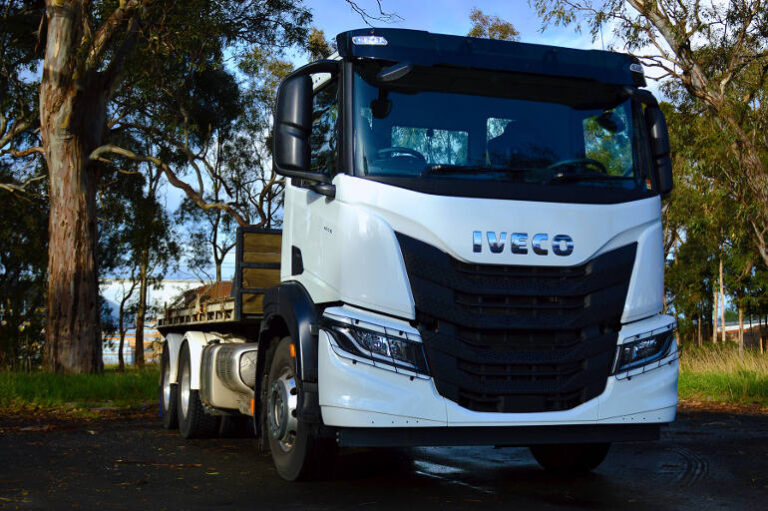National Heavy Vehicle Regulator
NHVR CEO Sal Petroccitto OAM said the regulator had long advocated for increased harmonisation of Australian vehicle standards with global standards.
“These changes will allow manufacturers to bring their latest designs, fitted with a full suite of safety and environmental technologies, to market in Australia,” Mr Petroccitto said.
“Several years ago, the NHVR identified current width limits as a barrier to the take up of safety technologies in our Vehicle Safety and Environmental Technology Uptake Plan (Vehicle SETUP).
“We have been working with the Commonwealth, our partners and industry to explore how we can enact change to align with international standards and promote the highest possible level of safety.
“The changes introduced by the Safer Freight Vehicles package will ensure the safest vehicles are available in Australia – helping to keep drivers, pedestrians and all road users safe.”
The NHVR will continue to work with the National Transport Commission and Governments to reflect the new changes in the Heavy Vehicle National Law.
The changes announced also remove dimension barriers that prevented heavy vehicle operators voluntarily fitting optional safety features to their vehicles, such as mirror and camera systems.
“Heavy vehicle operators have shown they are proactive in taking up safety features, but sometimes regulations have stood in their way. The changes made today by the Australian Government remove these barriers and support improving road safety.”
Truck Industry Council
The Truck Industry Council (TIC) welcomes the Federal Government’s announcement approving the implementation of the Safer Freight Vehicles Package and thanks Ministers Catherine King and Carol Brown for their open engagement.
TIC is the peak industry body and advocacy voice for Australian Truck Manufacturers and Importers, heavy vehicle engine companies and major component suppliers to the Federal and State Governments. TIC members represent 99% of all new truck sales above 4.5 tonne GVM in Australia.
“This announcement of the Safer Freight Vehicles Package demonstrates the strong, trusted working relationship that exists between the Truck Industry Council and the Federal Government.” said Mr Tony McMullan TIC CEO.
“As the industry technical experts, TIC has drawn upon its members’ world-wide technological and practical knowledge to advocate for the introduction of advanced safety features, that are core elements of this Safer Freight Vehicles Package, well before they are mandated, with the result being that road users will be safer on Australian roads.”
“All safer freight vehicles will now be equipped with lane departure warning, autonomous emergency brake systems, side underrun protection, conspicuity markings and stability control.”
“Allowing 2.55m width vehicles on Australian roads meant that these vehicles could be fitted with the latest safety technologies and importantly will result in the faster deployment of zero emission vehicles in Australia.” Mr McMullan said.
Electric Vehicle Council
EVC chief executive Behyad Jafari said the electric vehicle industry has been calling for the change for several years. The EVC congratulates the government for working collaboratively with industry and other stakeholders to deliver this important change.
“Increasing the width limit of trucks brings Australia in line with major overseas markets, like the EU, which is vital if we want to increase the supply of electric trucks on our roads,” Mr Jafari said.
“Being out of step with international regulation has restricted the supply of electric trucks into Australia. Aligning these standards will make it simpler and cheaper for Australian operators to access electric trucks, while also improving productivity, freight efficiency and safety.
“Australia is dependent on trucks to deliver goods across our massive nation, meaning they make up around one-fifth of the country’s transport emissions. Having more electric trucks crossing the country will reduce transport emissions, improve air quality, cut the cost of freight and reduce operating costs for owners as we decrease our reliance on expensive, imported fuel.
“As the adoption of electric trucks accelerates around the world, it’s vital that Australia stops falling behind. Increasing the width limit is a great first step, but we need to keep the momentum going to support our country’s electrification of trucks.
“We encourage the federal government to build on this announcement by introducing a mass concession (one tonne minimum) for electric trucks, and making it cheaper and attractive for Australian businesses wanting to embrace this technology. More broadly, we need a National Electric Heavy Vehicle Strategy that outlines a plan to decarbonise our heavy vehicle fleet over the long haul.”
Australian Trucking Association
ATA Chair David Smith said the increase in truck width to the 2.55 metre European standard would save the cost of redesigning European trucks for Australia.
“Future design changes will be increasingly difficult or not economical to adapt to Australia’s small market. This will include battery or hydrogen trucks,” David said.
David welcomed the safety package for the wider trucks, which includes better indirect vision, lane departure warning, side underrun protection and high visibility marking.
“The new requirements for seeing into blind spots will increase safety for car drivers, pedestrians and cyclists,” David said.
“But at the same time, drivers need to be able to use their rear vision mirrors to reverse their trucks with precision.
“We were able to reach an agreement on truck rear vision mirrors that will improve visibility and ensure drivers can still use their mirrors as they were trained.
David said there was still work to be done on truck width.
“There is a compelling case for widening trucks and trailers to the US 2.6 metre standard, which would deliver more safety and productivity gains.
“As the next step, the Government should increase the width of trailers to 2.55 metres, and allow trucks and trailers with flat sides, like refrigerated trucks, to be 2.6 metres wide,” he said.






